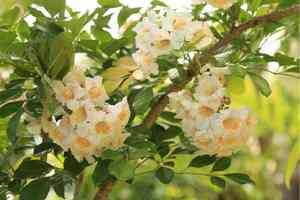The China doll plant is a widely available contemporary houseplant and highly well-liked. This plant resembles a tree with appealing, glossy, mid-green leaves separated into leaflets. This plant is relatively compact. China doll plants might be difficult to care for, but if you understand their growth fundamentals, you can enjoy having them in your house.

China doll plants are a lovely addition to any indoor home garden collection because of their small size and glossy emerald foliage. China doll plants are evergreen trees indigenous to Asia’s subtropical mountainous regions and belong to the Bignoniaceae family. They grow more efficiently indoors and, when properly cared for, may mature to heights of 4 to 6 feet.
China Doll plant: Key facts
Botanical Name Radermachera sinica
Common Name China doll plant, emerald tree, serpent tree
Plant type Broadleaf evergreen
Mature Size 4–6 ft. tall (indoors), 1–3 ft. wide (indoors)
Sun Exposure Full sun, Partial shade
Soil Type Moist but well-drained
Soil pH Neutral to Acidic
Bloom Time Summer (rarely blooms indoors)
Flower Color White, Yellow
Hardiness Zones 10–12 (USDA) when outdoors
Native Area Asia
China Doll plant: Varieties
A total of seventeen distinct species of China doll plants exist nowadays. Due to its silky, satiny appearance, this plant is known by various popular names, including Canton Lace and Emerald Tree.
The China doll plant also comes in a few unique variants, such as the Crystal Doll, a yellow-green variegated variety. Asian Bell Trees, also available in dwarf types, are growing in popularity.
No matter which China doll plant kind you keep as an indoor plant, it is unquestionably an excellent choice to give your space a regal feel.
China Doll plant: Care tips
China doll plants may be fussy if the right circumstances are not fulfilled for them to flourish well indoors. The most crucial thing to remember while growing a China doll plant is that it needs a lot of light and moisture and does not respond well to frequent changes in its growth environment.
China doll plants frequently experience leaf loss if their growth circumstances are unfavourable or change too fast.
China Doll plant: Sunlight requirements
For China doll plants to flourish inside, they need a lot of medium- to an indirect solid light. Pick a location next to a window but be careful to keep your plant out of any intense direct sunlight because it might burn the plant’s fragile leaves and result in leaf drops.
If your house does not provide a China doll plant with the minimum amount of natural light (four to five hours per day, regularly), you may supplement with an artificial grow light to make it more successful.
China Doll plant: Soil requirements
Put your China doll plant in a soil mixture that is both wet and well-draining.
Most times, potting combinations from the store are sufficient, but if you see that the soil is not draining effectively, you can add perlite or sand to aid drainage.
China Doll plant: Water requirements
Regular watering is essential for a China doll plant to be happy and healthy. The watering frequency will vary based on the season and climate in your home once the top inch of soil is dry.
However, China doll plants should not be overwatered since they cannot tolerate “wet feet” and can quickly develop root rot if kept in water for an extended period.
Choose a pot with many base drainage holes to avoid this problem.
It is a good sign that the plant needs more water if you see the leaves turning yellow or becoming crispy. Black points on the plant’s leaves might also indicate overwatering.
China Doll plant: Temperature and humidity requirements
The warm, humid environment in your house is ideal for China doll plants because of their subtropical roots.
While they can live in the ordinary dry domestic environment and should be kept in a temperature range of 65 to 75 degrees Fahrenheit, they will flourish if provided with more humidity.
Keep your China doll plant in a part of your house that usually has more humidity, such as the kitchen or bathroom, to boost the moisture surrounding it. The plant can also be placed next to a humidifier or misted daily.

